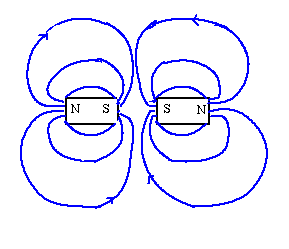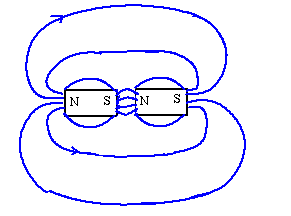
If we hang a bar magnet from a string, so that it is free to turn, we find that it tends to always point the same direction (if there are no other magnets or magnetic materials nearby). The explanation is that the Earth itself is a magnet! We have made a magnetic compass. By convention we label the ends of the magnet N and S, for the directions the ends are pointing. We call these the N pole and the S pole.
It is useful to make a map of the region surrounding a magnet, with arrows showing which way a compass needle will point. This set of arrows is called the magnetic field. For some cases it is enough to consider the field in one plane (the surface the magnet is lying on), but in general we would have to determine the direction of the compass needle for all points in three-dimensional space. We can connect the arrows together to make lines running from one pole to the other. We can draw as many lines as we like, but we should draw more lines from a strong magnet than from a weak one.
The lines all start and end at the poles. Necessarily they are close together there, and then spread out farther away from the magnet. This corresponds to the weaker magnetic field there.
Near the ends of the magnet, the lines are close together, while far away, they spread out. In the theory of magnetism, these "magnetic field lines" have meaning; it is possible to explain how a magnet behaves in terms of the field lines. For example, the assumption that the field lines can only end on a magnet forces the lines to spread out in a particular way, leading to a specific rule for how the magnetic field weakens away from the magnet.

We can also qualitatively account for the magnetic attraction, if we assume that it costs energy to have field lines in a region, especially if they are squeezed together. This extra "magnetization" energy is added when the magnet is made; magnets will lose this energy and become demagnetized if they are heated or treated roughly.
When we bring two magnets together N to S, the high field regions at the
two ends that are coming together decrease in size (and finally are eliminated when
the two magnets touch). This represents a decrease in energy, and so the magnets
are pulled together (just as a ball rolls downhill to decrease its gravitational energy).

When we bring the magnets together S to S, however, this crowds the field lines, making the high field region larger and raising the energy. So the magnets repel.
The field lines have lower energy when they are inside certain materials -- iron and steel being the main common examples. Moving a piece of iron towards a magnet again lowers the potential energy of the system, which means that there is a force of attraction in this case, too.
Magnets always have equal amounts of N and S polarity, so that every field line must start and end on the the magnet (or on some magnet, if there is more than one). In particular, there is no magnet or combination of magnets that have field maps like this


The rubber magnetic stuff that is used for "refrigerator magnets" has the poles arranged in stripes, because this makes more lines close to the rubber magnet, so that it sticks to the refrigerator better.
Check the box when you are
done:
Next:Discussion of magnets